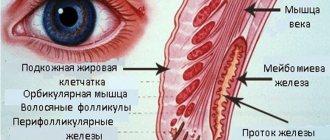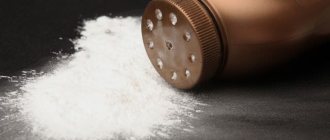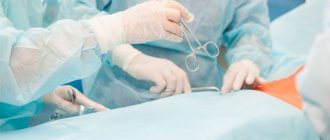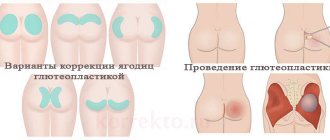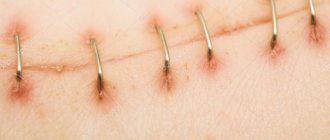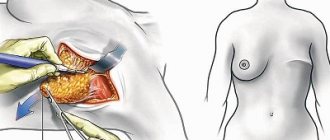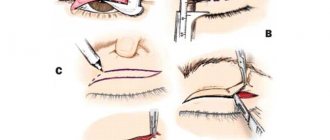Photos before/after blepharoplasty
View all photos
What is blepharoplasty
Blepharoplasty is eyelid surgery. It solves the following problems:
- drooping of the upper eyelid due to excess skin, but not due to drooping eyebrows, which can only be solved by lifting the upper area of the face;
- bags under the eyes , also known as fatty hernias;
- sagging or inversion of the lower eyelid.
I perform this operation most often as part of periorbital rejuvenation or total facelift, and very rarely in isolation. It is important to understand that blepharoplasty does not rejuvenate:
Abdominoplasty
The aesthetically acceptable contours of the abdomen can change over time, especially in women, and the main reason for these changes is pregnancy.
The skin and muscles of the anterior abdominal wall are mechanically stretched and relaxed. Collagen fibers, unable to withstand tension, rupture, which leads to the appearance of multiple stretch marks. After childbirth, in addition to drooping skin, separation of the rectus abdominis muscles is often observed. The abdomen becomes too convex even without pronounced subcutaneous fat. Significant accumulation of fatty tissue in the abdominal area due to poor nutrition, hormonal imbalances, and hereditary predisposition, in addition to obvious aesthetic defects, causes great physical suffering to a person. Under the saggy skin fold, as a rule, persistent diaper rash appears. Excessive weight of a sagging abdomen changes the distribution of the load on the spinal column, and often women develop a specific orthostatic syndrome, manifested by urinary incontinence and lower back pain. Conditions are also created for the development of congestion in the lower extremities and varicose veins. In such cases, abdominoplasty can be considered as an operation for medical reasons. Before the operation. Before deciding to undergo surgery, the patient must clearly understand what changes should be expected from the intervention, where the scars will be located, and how the rehabilitation period will proceed. Abdominoplasty gives good results, but after the operation there are always quite large scars and the return to a full life takes several weeks. Overweight patients need to bring their weight back to normal, or at least stabilize it. Two weeks before surgery, everyone is prescribed a fasting diet. If you plan to remove a really “big belly” with tightening of the sagging muscular aponeurotic corset, it is recommended to wear a bandage 2-3 weeks before the operation so that the body adapts to the new conditions of increased intra-abdominal pressure. Patients planning to have a baby or lose weight should postpone surgery. Pregnancy, like weight loss, usually leads to new changes in the shape of the abdomen and can worsen the outcome of the operation.
Operation. The abdominoplasty technique involves several stages. A skin incision is made in the lower abdomen, quite long from one hip to the other, and an incision is made around the navel. The skin-fat layer is separated from the muscles along the entire surface of the abdomen to the ribs, the navel remains between the abdominal muscles. The rectus abdominis muscles running in a vertical direction are brought closer to each other with sutures. This strengthens the anterior abdominal wall and somewhat narrows the waist. The skin of the abdomen is strongly stretched downwards, and the excess is removed, including most of the stretch marks. The navel is sewn in a new place, but in the same position where it was before the operation. Drainage tubes are inserted under the skin for 1-2 days and sutures are applied. If only the lower abdomen sags, and the skin above the navel is in good tone, a mini abdominoplasty can be performed. In this case, skin detachment is performed only to the level of the navel, the navel itself is not affected, and the postoperative scar remains much shorter. Often, to achieve the effect, liposuction is performed in the lateral parts of the body. If there are significant fat deposits in the area of the anterior abdominal wall, especially in its upper part, a 2-stage correction is justified: first, liposuction, and then, after about 6 months, a tummy tuck.
After operation. After the operation, an elastic bandage or corset is put on on the operating table, which you will wear for several weeks. The drainage tubes are removed after a day or two. For the first few days, you may feel pain and a feeling of tightness in the suture area. For the first 24 hours, the patient lies in bed on his back with his legs bent and a pillow under his knees to reduce the tension on the suture line. From the second day you can and even need to get up and move. After three days, as a rule, they are discharged home. Some patients can return to work within two weeks; for others, recovery lasts about a month. Most bruises disappear within 2-3 weeks; moderate swelling may persist for several months. The feeling of numbness in the skin of the abdomen disappears gradually. The scars will be pink during the first months. Over time, they will fade and become less noticeable. But they will never completely disappear. Tension and heavy lifting should be avoided for six months after surgery. During the year, the abdomen, especially in the area of scars, should be protected from direct sunlight; on vacation, creams with a sun filter should be used.
Risks and complications. Blood that accumulates in small quantities under the skin immediately after surgery should be removed through drains. For various reasons, this may not happen, and blood will collect in the wound. A small collection of blood may resolve on its own, but a large hematoma or ongoing bleeding requires intervention in the operating room. Sometimes it is not blood that accumulates under the skin, but serous fluid. In this case, it is enough to suck it out with a needle. The infection usually responds well to antibiotic therapy. Less commonly, this process may require a long stay for the patient in the clinic. Problems with the blood supply or infection can cause difficulty in the healing process, including suture dehiscence. This prolongs the healing period and sometimes results in rough scarring that can be corrected over time. Some areas of the skin lose sensitivity forever. A rare but life-threatening complication, fat embolism and thromboembolism.
Upper blepharoplasty
Upper blepharoplasty solves the problem of drooping upper eyelid due to excess skin and fatty tissue.
Algorithm for performing the operation:
- marking is carried out;
- an incision is made along the natural fold of the upper eyelid;
- excess skin is excised;
- the orbicularis oculi muscle is dissected and excess is removed;
- adipose tissue is redistributed or excised;
- an intradermal suture is performed.
This is called resection upper blepharoplasty . Since there are no other types, the word “resection” is often missed.
To whom and for what purpose is abdominoplasty performed?
Abdominoplasty or mini-abdominoplasty is performed on women or men who are over 18 years old and have no contraindications. The goal is to correct the appearance of the anterior abdominal wall. Abdominoplasty is an effective method of eliminating excess skin of the anterior abdominal wall without pronounced fat deposits.
- Fast weight loss.
- Tightness after childbirth and sagging skin. Note that postpartum tummy tuck is the most frequently performed intervention.
- A layer of skin and fat hanging down.
- Gender (sexual characteristics). For men, abdominal breathing is typical. The act of inhalation and exhalation is largely accompanied by a greater participation of the diaphragm and the muscles of the anterolateral abdominal walls. With age, this leads to their stretching;
- The above changes and scars after previous operations, as well as hernia of the anterior abdominal wall.
Contraindications
- Impaired blood clotting,
- Diabetes,
- Infectious diseases
- Cardiovascular diseases and respiratory system problems.
How is the operation performed?
Abdominal plastic surgery is the removal of excess skin and reduction of the fat layer. Due to this, the tension of the skin of the anterior abdominal wall is reduced and the thickness of the subcutaneous layer of this area is simulated. Doctors of the Krasnodar ENT clinic simultaneously solve all such problems as: eliminating possible hernias, eliminating the discrepancy of the rectus abdominis muscles, strengthening the aponeurosis when it is severely stretched. The extent of the operation depends on changes in the skin, the amount of subcutaneous fat, and the muscular aponeurotic layer. If the patient has a moderate degree of these changes, then it is enough to perform a mini abdominoplasty.
Mini abdominoplasty
By performing a mini abdominoplasty, surgeons remove excess skin and, if necessary, the subcutaneous fat layer. In such cases, there is no need to move the navel, since the amount of tissue removed allows the correct tension to be achieved. The incision in such cases is much smaller compared to a full tummy tuck.
Full abdominoplasty with navel relocation
Full tummy tuck is necessary when there is a pronounced change in the anterior abdominal wall, there is a large excess of skin and an excessive subcutaneous fat layer (cutaneous fat apron). In such cases, the tension of the surface layer of the anterior abdominal wall, which is necessary to give the abdomen a more aesthetic appearance, is achieved by removing more extensive skin areas. The consequence of this is the need to move the patient's navel. The postoperative suture after a full tummy tuck is longer compared to a mini abdominoplasty. Its length depends on the volume of areas of excess tissue being removed. Most often, performing a full abdominoplasty entails the need for additional strengthening of the aponeurotic layer, which helps eliminate sprains.
Operation duration
Duration varies from 50 min. up to 3 hours. In this case, it all depends on the volume and complexity.
Lower blepharoplasty
Lower blepharoplasty solves the problem of bags under the eyes and sagging/turning of the lower eyelid .
There are two types of lower blepharoplasty depending on the access:
- Transcutaneous (aka resection);
- Transconjunctival.
Incision options for lower blepharoplasty: transcutaneous and transconjunctival
The advantage of the transconjunctival approach is an invisible suture, which is located on the inside of the lower eyelid. Therefore, transconjunctival blepharoplasty is called “blepharoplasty without stitches.”
The advantage of the transcutaneous approach is the ability to remove excess skin:
Transcutaneous lower blepharoplasty
If you want to delve deeper into lower blepharoplasty, read my article with detailed anatomy and surgical technique.
How to remove bags under the eyes? Lower blepharoplasty or fillers.
Rehabilitation after blepharoplasty
It is necessary to understand that the result of the actions performed is not immediately noticeable; the postoperative period is accompanied by swelling and the formation of hematomas, which gradually decrease over the course of 5 to 14 days. This is a natural physiological process of response to surgical trauma. Removal of sutures, as a rule, occurs quickly and painlessly 4-5 days after the intervention.
For speedy healing, it is recommended not to rub your eyes during the first 7-10 days, touch them as carefully as possible if necessary, and follow all doctor’s recommendations. Cold compresses can be used to reduce swelling. After the intervention, antibacterial therapy is usually prescribed, including both medications and topical agents, such as ointments.
If you want to make your look young, beautiful, attractive, then you can have blepharoplasty in our clinic in Krasnodar. We guarantee the highest quality of surgeons' work, inexpensive prices, and attentive attitude towards patients.
Fat-sparing blepharoplasty
Age-related decrease in the volume of fatty tissues on the face and their migration under the influence of gravity
With age, the volume of fatty tissues on the face decreases and moves downward under the influence of gravity, forming hernias. Therefore, it is necessary to remove orbital fat when performing eyelid surgery according to strict indications. Most often, fat needs to be redistributed to restore the “youthful” position. Read more about the mechanisms of formation of lower eyelid hernias and the technique of fat-sparing lower blepharoplasty in my article.
How to remove bags under the eyes? Lower blepharoplasty or fillers.
Prices for blepharoplasty
| Plastic surgery | price, rub. |
| Upper blepharoplasty | 97 000 ₽ |
| Lower blepharoplasty, resection or transconjunctival, including canthopexy if indicated | 97 000 ₽ |
| Circumferential blepharoplasty, upper and lower blepharoplasty, including canthopexy if indicated | 147 000 ₽ |
| Periorbital rejuvenation Circular blepharoplasty + endoscopic lifting of the upper and middle areas of the face + lipofilling + correction of the upper eyelid levators, corrugators, nasolacrimal trough using own tissues | 375 000 ₽ |
| Lipofilling eyelids | 55 000 ₽ |
